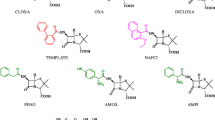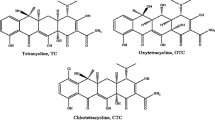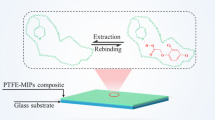Abstract
We have prepared molecularly imprinted beads with molecular recognition capability for target molecules containing the penicillanic acid substructure. They were prepared by (a) grafting mesoporous silica beads with 6-aminopenicillanic acid as the mimic template, (b) filling the pores with a polymerized mixture of methacrylic acid and trimethylolpropane trimethacrylate, and (c) removing the silica support with ammonium fluoride. The resulting imprinted beads showed good molecular recognition capability for various penicillanic species, while antibiotics such as cephalosporins or chloramphenicol were poorly recognized. The imprinted beads were used to extract penicillin V, nafcillin, oxacillin, cloxacillin and dicloxacillin from skimmed and deproteinized milk in the concentration range of 5–100 μg·L−1. The extracts were then analyzed by micellar electrokinetic chromatography by applying reverse polarity staking as an in-capillary preconcentration step, and this resulted in a fast and affordable method within the MRL levels, characterized by minimal pretreatment steps and recoveries of 64–90 %.

Penicillanic acid-imprinted beads prepared in preformed porous silica by an imprinting & etching approach show selectivity towards β-lactams antibiotics. Molecularly imprinted solid phase extraction/micellar electrokinetic chromatography coupled with in-capillary preconcentration resulted in a fast and affordable method for penicillins in milk at MRL levels.


Similar content being viewed by others
References
Viola C, De Vincent SJ (2006) Overview of issues pertaining to the manufacture, distribution, and use of antimicrobials in animals and other information relevant to animal antimicrobial use data collection in the United States. Prev Vet Med 73:111–131
Kools SAE, Moltmann JF, Knacker T (2008) Estimating the use of veterinary medicines in the European Union. Regul Toxicol Pharmacol 50:59–65
Blasco C, Torres CM, Picó Y (2007) Progress in a antibacterials analysis of residual in food. Trends Anal Chem 26:895–913
Stolker AAM, Zuidema T, Nielen MWF (2007) Residue analysis of veterinary drugs and growth-promoting agents. Trends Anal Chem 26:967–979
Samanidou V, Nisyriou S (2008) Multi-residue methods for confirmatory determination of antibiotics in milk. J Sep Sci 31:2068–2090
Le Bizec B, Pinel G, Antignac JP (2009) Options for veterinary drug analysis using mass spectrometry. J Chromatogr A 1216:8016–8034
Bogialli S, Di Corcia A (2009) Recent applications of liquid chromatography–mass spectrometry to residue analysis of antimicrobials in food of animal origin. Anal Bioanal Chem 395:947–966
Kinsella B, O’Mahony J, Malone E, Moloney M, Cantwell H, Furey A, Danaher M (2009) Current trends in sample preparation for growth promoter and veterinary drug residue analysis. J Chromatogr A 1216:7977–8015
Marazuela MD, Bogialli S (2009) A review of novel strategies of sample preparation for the determination of antibacterial residues in foodstuffs using liquid chromatography-based analytical methods. Anal Chim Acta 645:5–17
Baggiani C, Giovannoli C, Baravalle P, Anfossi L (2007) Solid phase extraction of food contaminants using molecular imprinted polymers. Anal Chim Acta 591:29–39
Skudar K, Brüggemann O, Wittelsberger A, Ramström O (1999) Selective recognition and separation of β-lactam antibiotics using molecularly imprinted polymers. Anal Commun 36:327–331
Lübke C, Lübke M, Whitcombe MJ, Vulfson EN (2000) Imprinted polymers prepared with stoichiometric template-monomer complexes: efficient binding of ampicillin from aqueous solutions. Macromolecules 33:5098–5105
Cederfur J, Pei Y, Zihui M, Kempe M (2003) Synthesis and screening of a molecularly imprinted polymer library targeted for penicillin G. J Comb Chem 5:67–72
Benito-Pena E, Moreno-Bondi MC, Aparicio S, Orellana G, Cederfur J, Kempe M (2006) Molecular engineering of fluorescent penicillins for molecularly imprinted polymer assays. Anal Chem 78:2019–2027
Urraca JL, Hall AJ, Moreno-Bondi MC, Sellergren B (2006) A stoichiometric molecularly imprinted polymer for the class-selective recognition of antibiotics in aqueous media. Angew Chem Int Ed 45:5158–5161
Urraca JL, Hall AJ, Moreno-Bondi MC, Sellergren B (2007) Direct extraction of penicillin G and derivatives from aqueous samples using a stoichiometrically imprinted polymer. Anal Chem 79:695–701
Zhang J, Wang H, Liu W, Bai L, Ma N, Lu J (2008) Synthesis of molecularly imprinted polymer for sensitive penicillin determination in milk. Anal Lett 41:3411–3419
Beltran A, Marcè RM, Cormack PAG, Sherrington DC, Borrull F (2008) Selective solid-phase extraction of amoxicillin and cephalexin from urine samples using a molecularly imprinted polymer. J Sep Sci 31:2868–2874
Kempe H, Kempe M (2010) Influence of salt ions on binding to molecularly imprinted polymers. Anal Bioanal Chem 396:1599–1606
Kempe H, Kempe M (2010) QSRR analysis of β-lactam antibiotics on a penicillin G targeted MIP stationary phase. Anal Bioanal Chem 398:3087–3096
Yin J, Meng Z, Du M, Liu C, Song M, Wang H (2010) Pseudo-template molecularly imprinted polymer for selective screening of trace β-lactam antibiotics in river and tap water. J Chromatogr A 1217:5420–5426
Zhang X, Chen L, Xu Y, Wang H, Zeng Q, Zhao Q, Ren N, Ding L (2010) Determination of β-lactam antibiotics in milk based on magnetic molecularly imprinted polymer extraction coupled with liquid chromatography–tandem mass spectrometry. J Chromatogr B 878:3421–3426
Kubo T, Hosoya K, Watabe Y, Tanaka N, Sano T, Kaya K (2004) Recognition of hepatotoxic homologues of microcystin using a combination of selective adsorption media. J Sep Sci 27:316–324
Yilmaz E, Haupt K, Mosbach K (2000) The use of immobilized templates. A new approach in molecular imprinting. Angew Chem Int Ed Engl 39:2115–2118
Cheong SH, McNiven S, Rachkov A, Levi R, Yano K, Karube I (1997) Testosterone receptor binding mimic constructed using molecular imprinting. Macromolecules 30:1317–1322
Baggiani C, Baravalle P, Giovannoli C, Anfossi L, Passini C, Giraudi G (2011) Binding behaviour of molecularly imprinted polymers prepared by a hierarchical approach in mesoporous silica beads of varying porosity. J Chromatogr A 1218:1828–1834
Nawrocki J (1997) The silanol group and its role in liquid chromatography. J Chromatogr A 779:29–71
Author information
Authors and Affiliations
Corresponding author
Electronic supplementary material
Below is the link to the electronic supplementary material.
ESM 1
(DOC 104 kb)
Rights and permissions
About this article
Cite this article
Giovannoli, C., Anfossi, L., Biagioli, F. et al. Solid phase extraction of penicillins from milk by using sacrificial silica beads as a support for a molecular imprint. Microchim Acta 180, 1371–1377 (2013). https://doi.org/10.1007/s00604-013-0980-0
Received:
Accepted:
Published:
Issue Date:
DOI: https://doi.org/10.1007/s00604-013-0980-0




